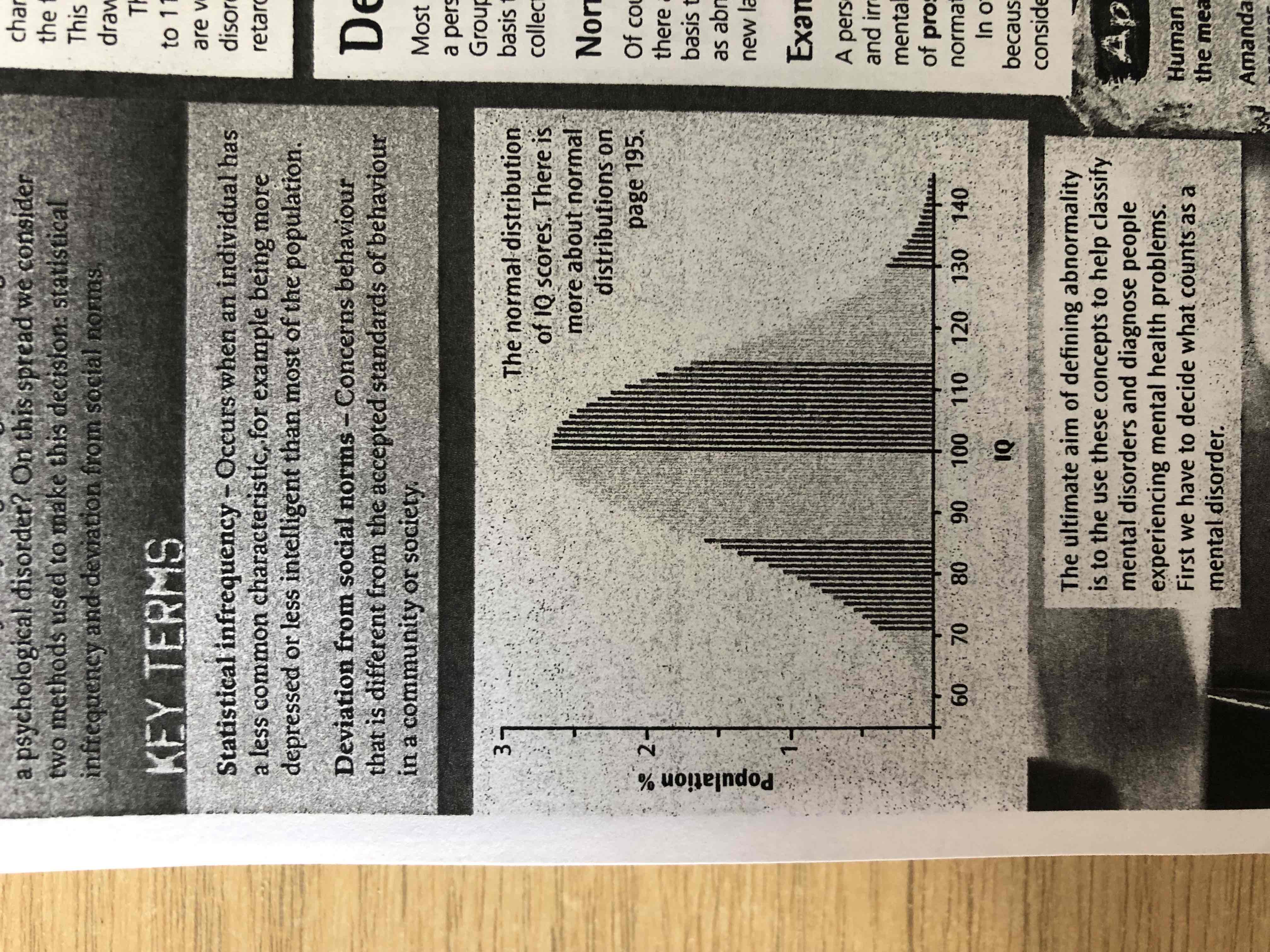Definitions of abnormality
1/12
There's no tags or description
Looks like no tags are added yet.
Name | Mastery | Learn | Test | Matching | Spaced |
|---|
No study sessions yet.
13 Terms
what is statistical infrequency?
occurs when an individual has a less common characteristic (any relatively usual behaviour of characteristic can be thought of as ‘normal’ and anything different to this can me thought of as ‘abnormal’
Eg- being more depressed or less intelligent than most of the population
What is normal distribution? (with an example)
eg- intelligence- in any human characteristic the majority of peoples scores cluster around the average, and the further people go above or below that average, the fewer people will attain that score
This is normal distribution

What is intellectual disability disorder?
avg IQ set at 100
Most people (68%) have an IQ in the range from 85 to 115
Only 2% have a score below 70
Those individuals are every unusual or ‘abnormal’ and are liable to receive a diagnosis of a psychological disorder- intellectual disability disorder
what is deviation from social norms?
Concerns behaviour that is different from the accepted standards of behaviour in a community or society
why does norms being specific to the culture we live mean that there are not many things we find universally abnormal?
social norms may be different for each generation and every culture, so there are relatively few behaviours that would be considered universally ‘abnormal’ on the basis that they breach social norms
Eg- homosexuality continues to be viewed as abnormal (and illegal) in some cultures
What is antisocial personality disorder and why is it considered abnormal?
person with this disorder (psychopathy) is impulsive, aggressive and irresponsible
According to DSM-5 (the manual used by psychiatrists to diagnose mental disorder) one important symptom of this is an ‘absence of prosocial internal standards associated with failure to conform to lawful or culturally normative ethical behaviour
evaluation- real-life application
strength of statistical definition- has real life application in diagnosis of intellectual disability disorder, so there’s a place for stats infrequency in thinking about what are normal and abnormal behaviours and characteristics
assessment of patients with mental disorders includes some kind of measurement of how severe their symptoms are as compared to statistical norms- so stats infrequency=useful part of clinical assessment
evaluation- unusual characteristics can be positive (stats infrequency)
IQ scores over 130 are just as unusual as those below 70, but this doesn’t mean it’s an undesirable characteristic that needs treatment- just because very few people display certain behaviours does make the behaviour statistically abnormal but doesn’t mean it requires treatment to return to normal
serious limitation to concept of stat infrequency and means hat it would never be used alone to make a diagnosis
evaluation- not everyone unusual benefits from a label (stats infrequency)
another problem- where someone is living a happy, fulfilled life, there’s no benefit to them being labelled as abnormal regardless of how unusual they are
so someone with a very low IQ but who wasn’t distressed, quite capable of working, etc, wouldn’t need diagnosis of intellectual disability
if that person was labelled as ‘abnormal’ this might have a negative effect on the way others view them and the way they view themselves
evaluation- (deviation from social norms)- not a sole explanation
strength- has real-life application in diagnosis of antisocial personality disorder- so there’s a place for deviation from social norms in thinking about what’s normal and abnormal
but, even in this case there are other factors to consider, eg- the distress to others resulting from APD (the failure to function definition)
so, in practice, deviation from social norms is never the sole reason for defining abnormality
evaluation- (deviation from social norms)- cultural relativism
another problem- social norms vary largely from one gen to another and from one community to another- this means, eg, that a person from one cultural group may label someone from another culture as behaving abnormally according to their standards rather than the standards of the person behaving that way
eg- hearing voices is socially acceptable in some cultures but would be seen as a sign of mental abnormality in the UK- creates a problem for people from one culture living within another culture group
evaluation- can lead to human rights abuses (DSN)
too much reliance on deviation from social norms to understand abnormality can also lead to systematic abuse of human rights
looking at historical examples of deviation from social norms, it’s clear that some diagnoses were there to maintain control over minority ethnic groups and women
the classifications appear ridiculous nowadays- only as our social norms have changed- more radical psychologists suggest that some of our modern categories of mental disorder are really abuses of people’s rights to be different
evaluation- social vs statistical norms
strength of DSN approach is that it includes the issue of desirability of a behaviour- the stats infrequency approach doesn’t take desirability into account
eg- genius is statistically abnormal but we wouldn’t want to include that in our definition of abnormal behaviours- means that social norms can be more useful than statistical norms